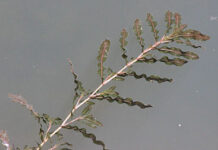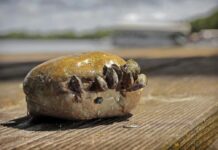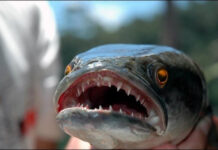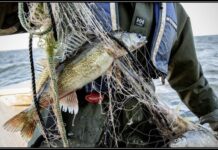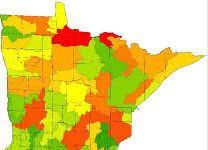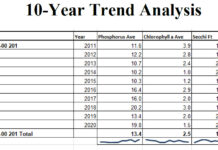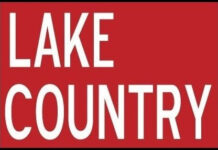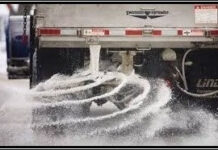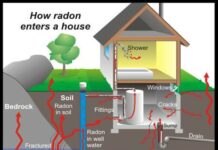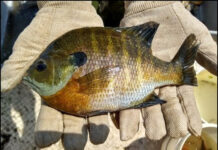What’s the problem with Lead?
Did you know that the vast majority of fishing tackle currently available on the market is made out of lead? Lead is a toxic metal that is lethal in small amounts to common loons and other wildlife, including trumpeter swans and bald eagles. Across the United States, lead poisoning is a leading cause of death for loons. An estimated 25% of loons die from lead poisoning, primarily from swallowing lead jigs and sinkers. Loons consume fishing tackle in several ways:
- Picking up lost tackle found on the bottom of lakes when they gather pebbles for their gizzards to help them grind and digest food
- Striking at a bait or caught fish as it is being retrieved by an angler
- Eating a fish that has ingested tackle or has tackle attached
Lead has negative effects on the nervous and reproductive systems of mammals and birds. Loons with lead poisoning exhibit physical and behavioral changes, such as loss of balance, gasping, tremors, and limited flying abilities. Because of these symptoms, loons are more vulnerable to predators and have difficulty feeding, mating, nesting, or caring for their young. Depending on the quantity of lead swallowed, lead poisoning will kill a loon in two days to three weeks.
Why is this important?
The common loon is Minnesota’s iconic state bird, and it’s no wonder seeing as Minnesota has the largest loon population in the continental US! Loons are also an integral part of Minnesota’s local ecosystems. Loons face various threats, such as climate change, habitat loss, and predation. Additional deaths by lead poisoning can be easily prevented by switching to lead-free tackle.
What can I do to help?
Fear not! There are many ways you can prevent loon deaths from lead poisoning.
1. If you fish…
…switch to lead-free tackle! Alternatives to lead are more common, popular, and better performing now than they have been in the past. The next time you buy tackle, consider these materials: tungsten, bismuth, steel, tin, glass, stone, or metal composite.
…ask for lead-free tackle alternatives at retailers and shops. This may increase the need for vendors to supply these products and show that there is consumer demand. Explore the list of companies that produce lead-free tackle, provided by the Minnesota Pollution Control Agency’s (MPCA) Get the Lead Out (GTLO) program: GTLO lead-free manufacturer page
2. If you don’t fish…
…you can spread the word. Make others aware of this issue and encourage anglers you know to switch to lead-free tackle. Especially encourage young and beginner anglers to use lead-free tackle, which is non-toxic and safer to handle.
3. Dispose of your lead tackle…
…at your local household hazardous waste (HHW) collection site or other organizations that accept lead tackle. Do not throw your old lead tackle in the trash! For Minnesotans, you can find your local HHW on the MPCA’s website.
4. Found a sick, injured, or dead loon?
For sick and injured loons, contact your local wildlife rehabilitation center. Other fishing related threats to loons include fishing line entanglements, hook attachments, and boat collisions. The wake from boats also damages loon habitat and nests.
For a list of Minnesota wildlife rehabilitation centers by county, visit the MN DNR’s Wildlife Rehabilitation list by County.
For dead loons, contact the Minnesota DNR. Their statewide mainline is 651-296-6157 (St. Paul). They can connect you to a local DNR office, nongame wildlife specialist, or conservation officer.
5. Get involved with the MPCA’s Get the Lead Out program
Get the Lead Out (GTLO) is a program within the Minnesota Pollution Control Agency. The program’s goal is to protect the common loon through education and outreach that encourages anglers to use lead-free fishing tackle.
There are numerous partnership opportunities with GTLO, including tackle exchanges, education/outreach, and sport shows. Get the Lead Out is also open to new opportunities. If you are interested in partnering with GTLO, contact them at leadout@state.mn.us
Follow Get the Lead Out on social media to get the latest information and learn about upcoming events:
Facebook: www.facebook.com/LeadOutMN
Instagram: @LeadOutMN
6. Get involved with the DNR’s Loon Monitoring Program and Loon Watcher Survey
These voluntary, citizen science efforts are a part of the DNR’s Nongame Wildlife Program. Hundreds of volunteers count common loons and collect survey information and data from various lakes. With up-to-date data, it is easier to assess, monitor, and understand Minnesota’s common loon population and their environment.
Learn more about the loon monitoring program and sign up to volunteer here.
Learn more about the Loon Watcher Survey here.

